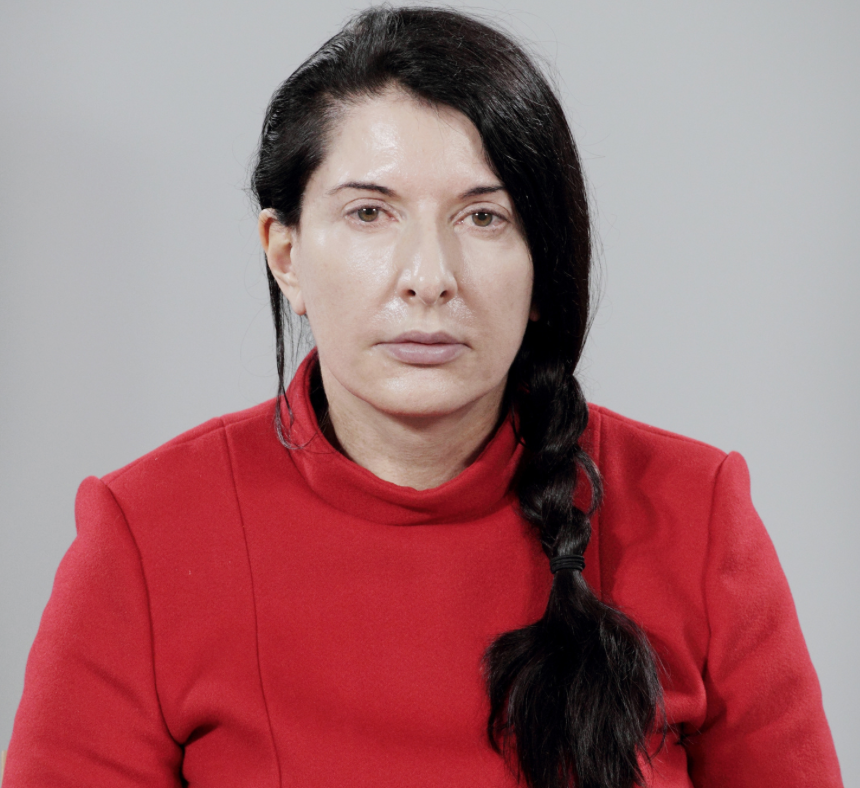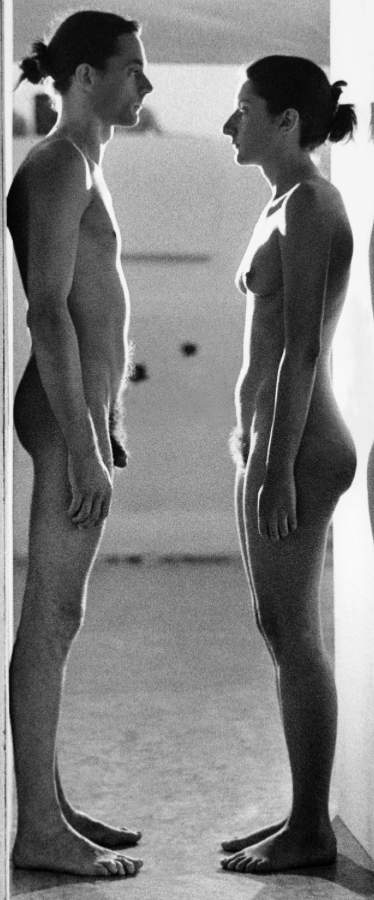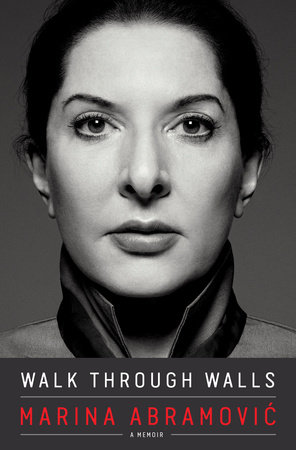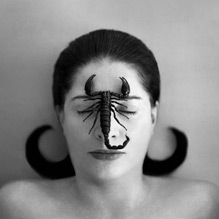 To experience the work of performance artist Marina Abramović is to step outside of the time-space continuum. That’s how she likes it, I think, and that is why we flock to her unblinking gaze. This was most literally true at her “The Artist Is Present” show, which exhibited at New York’s Museum of Modern Art in the spring of 2010 and to date may be the most famous performance art piece of this millennium. In it, she took over the museum’s atrium and, adorned in a floor-length dress of wool and cashmere, sat eight hours each day in an armless chair as she silently held the gaze of every visitor who sat opposite her.
To experience the work of performance artist Marina Abramović is to step outside of the time-space continuum. That’s how she likes it, I think, and that is why we flock to her unblinking gaze. This was most literally true at her “The Artist Is Present” show, which exhibited at New York’s Museum of Modern Art in the spring of 2010 and to date may be the most famous performance art piece of this millennium. In it, she took over the museum’s atrium and, adorned in a floor-length dress of wool and cashmere, sat eight hours each day in an armless chair as she silently held the gaze of every visitor who sat opposite her.
As news of this exhibition spread, more and more people clamored to attend (especially after Lady Gaga made an appearance); lines stretched around half of Midtown for a chance to sit opposite Abramović. Once there, some stayed many minutes; others for only a few seconds. Celebrities, security guards, students: everyone was granted the same attention, the same degree of respect. Some sat across from her three or four times, spending days in line each time to do so. Some laughed or smiled. Many wept. The artist often wept as well. What took place was seemingly the simplest exchange possible: Two humans recognized each other silently in the presence of others. And yet, almost every participant reported a profound experience – joy, fear, grief, transcendence.
The event was not just artistic; it was spiritual–a mass communion that yanked every participant out of his or her time and space concerns. Though it was not acknowledged as such, “The Artist Is Present” might have been one of the most high-profile religious events in modern history. Certainly it was the ultimate application of what the artist calls the “Abramović” method – a process of achieving timeless truths through repetition, often of physically and mentally wrenching tasks.
I mention all this  because to read Walk Through Walls, Abramović’s new memoir, is also to experience a variant of the Abramović method. This is not to say the book is a slog. Rather, its crafty tangle of personal revelation and professional journaling – of romantic suffering and creative swoons – pulls you right out of normal time-space concerns. I began reading it early on a busy Wednesday morning, and when I next looked up the sun had set and my phone was buzzing with angry messages about missed appointments and deadlines. I suspect I will not be alone in this, for to comprehend Abramović’s personal narrative is to surrender to it. Her writing, visceral and clear, channels both the stubborn purity and the carnal, almost grotesque seduction of even her earliest work. Her unique body politic–as well as the holy-unholy relationship between the creative and divine creation–can be found in her account of her difficult childhood, philosophies and endeavors, and the demise of once-hallowed romantic relationships.
because to read Walk Through Walls, Abramović’s new memoir, is also to experience a variant of the Abramović method. This is not to say the book is a slog. Rather, its crafty tangle of personal revelation and professional journaling – of romantic suffering and creative swoons – pulls you right out of normal time-space concerns. I began reading it early on a busy Wednesday morning, and when I next looked up the sun had set and my phone was buzzing with angry messages about missed appointments and deadlines. I suspect I will not be alone in this, for to comprehend Abramović’s personal narrative is to surrender to it. Her writing, visceral and clear, channels both the stubborn purity and the carnal, almost grotesque seduction of even her earliest work. Her unique body politic–as well as the holy-unholy relationship between the creative and divine creation–can be found in her account of her difficult childhood, philosophies and endeavors, and the demise of once-hallowed romantic relationships.
Born in 1946 in Yugoslavia to a pair of charismatic Communist party heavies who already hated each other, Abramović was raised in a large and baroque apartment impeccably ordered by her mother, as emotionally and physically abusive as she was obsessive-compulsive. Her philandering father may have absentmindedly doted on Marina but her only consistent nurturing came from a devoutly and superstitiously Christian grandmother, who hid her religious practices lest they cause trouble with the government. “Communism mixed with mysticism is very much part of my DNA,” the artist writes.“To comprehend Abramović’s personal narrative is to surrender to it.”
Even as a child, “extreme narratives” fascinated Marina, who found escape in books and dreams. For her fourteenth birthday, her father gave her a lesson with a local abstract artist who made a painting from gasoline, sand, and yellow and red pigment that he lit on fire. “This taught me the process was more important than the result, just as the performance meant more to me than the object,” she writes. Herein lie the seeds of her performance art as well as a core ethos – namely, “the artist is present.”
Marina describes how a fellow college student visited her in ghost form a few days after committing suicide. “I became convinced that when we die, the physical body dies, but its energy doesn’t disappear – it just takes different forms,” she writes. “The reality we see now is a certain frequency, and we’re all on that same frequency so we’re  visible to each other, but it’s possible to change frequencies and enter a different reality …. There are hundreds of these realities.”
visible to each other, but it’s possible to change frequencies and enter a different reality …. There are hundreds of these realities.”
It would be easy enough to dismiss such passages as frippery, but Abramović’s narrative bears out this mysticism. From the beginning of her decades-long collaboration with romantic and artistic partner Ulay, the two experienced remarkable synchronicities (even sharing a birthday they both hated). This alliane formed the backbone of their performance pieces, which notoriously explored danger and trust, the profane and the sacred. They walked the entire Wall of China, apprenticed in a wide range of cultural contexts, including with Tibetan monks and Aboriginal people, and even began to practice a sort of telepathy that Abramović describes without editorialization. This laconicism underscores much of her work, including “The House with the Ocean View,” in which she explores changing energy frequencies by living in an installation without speaking or eating. (She did urinate and drink, and, yes, this was mocked in an episode of “Sex and the City.”) It is of note that a disavowal of speech is also a chief tenet of many spiritual practices.
Actually, as so much of Marina’s work is based on silence, it’s rather extraordinary to read her book-length testimony. Because her art is grounded in a mysticism rarely discussed in mainstream contexts without metaphorically raised eyebrows; because she discusses psychic phenomena so matter-of-factly; because she has suffered as an immigrant, a woman, and as an artist; and because her work is a uniquely arduous magic full of dangerous tests and trials for herself and others (she once equipped audiences with weapons to attack her), she embodies the essence of a spiritual leader. Ambramović is not so much a cultural tourist as someone who uses art to powerfully connect with various cultural consciousness – with human and superhuman consciousness, period. This is the opposite of cultural tourism; it is what we hoped would come about from multiculturalism  and global community but rarely does.
and global community but rarely does.
To observe the art of Abramović and to read this book is to engage with her processes. It is not only the Artist who is present. Everyone touched by her work – even those wondering why those huge lines formed around MOMA – is also present, however briefly. This sixtysomething Yugoslavian immigrant has effectively launched a movement, and she’s done it without a TV program, a pulpit, or a self-help book – that is, unless you count this one.
This was originally published at Signature.
